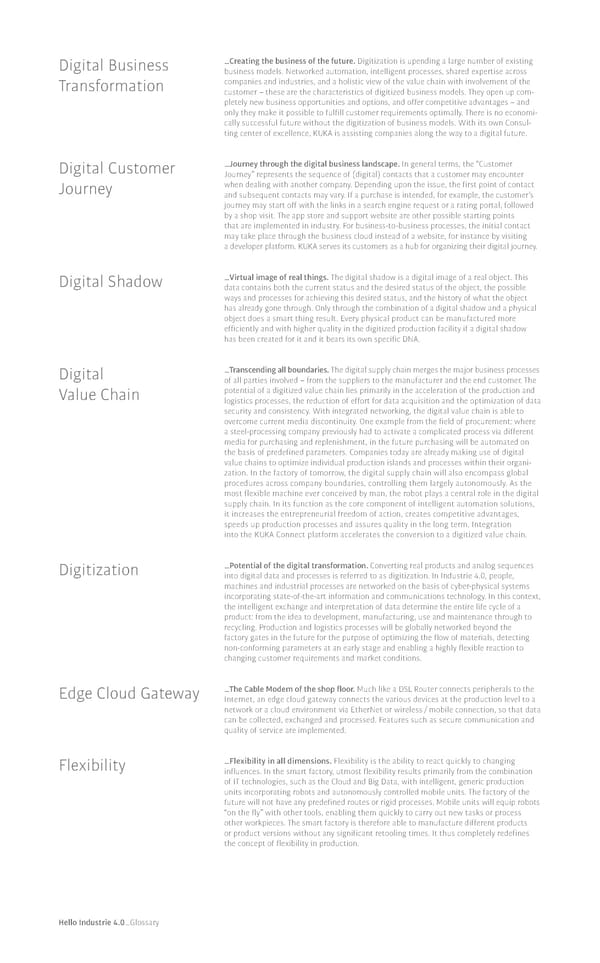Digital Business �Creating the business of the future. Digitization is upending a large number of existing business models. Networked automation, intelligent processes, shared expertise across Transformation companies and industries, and a holistic view of the value chain with involvement of the customer – these are the characteristics of digitized business models. They open up com- pletely new business opportunities and options, and offer competitive advantages – and only they make it possible to fulfill customer requirements optimally. There is no economi- cally successful future without the digitization of business models. With its own Consul- ting center of excellence, KUKA is assisting companies along the way to a digital future. Digital Customer �Journey through the digital business landscape. In general terms, the “Customer Journey” represents the sequence of (digital) contacts that a customer may encounter Journey when dealing with another company. Depending upon the issue, the first point of contact and subsequent contacts may vary. If a purchase is intended, for example, the customer’s journey may start off with the links in a search engine request or a rating portal, followed by a shop visit. The app store and support website are other possible starting points that are implemented in industry. For business-to-business processes, the initial contact may take place through the business cloud instead of a website, for instance by visiting a developer platform. KUKA serves its customers as a hub for organizing their digital journey. Digital Shadow �Virtual image of real things. The digital shadow is a digital image of a real object. This data contains both the current status and the desired status of the object, the possible ways and processes for achieving this desired status, and the history of what the object has already gone through. Only through the combination of a digital shadow and a physical object does a smart thing result. Every physical product can be manufactured more efficiently and with higher quality in the digitized production facility if a digital shadow has been created for it and it bears its own specific DNA. Digital �Transcending all boundaries. The digital supply chain merges the major business processes of all parties involved – from the suppliers to the manufacturer and the end customer. The Value Chain potential of a digitized value chain lies primarily in the acceleration of the production and logistics processes, the reduction of effort for data acquisition and the optimization of data security and consistency. With integrated networking, the digital value chain is able to overcome current media discontinuity. One example from the field of procurement: where a steel-processing company previously had to activate a complicated process via different media for purchasing and replenishment, in the future purchasing will be automated on the basis of predefined parameters. Companies today are already making use of digital value chains to optimize individual production islands and processes within their organi- zation. In the factory of tomorrow, the digital supply chain will also encompass global procedures across company boundaries, controlling them largely autonomously. As the most flexible machine ever conceived by man, the robot plays a central role in the digital supply chain. In its function as the core component of intelligent automation solutions, it increases the entrepreneurial freedom of action, creates competitive advantages, speeds up production processes and assures quality in the long term. Integration into the KUKA Connect platform accelerates the conversion to a digitized value chain. Digitization �Potential of the digital transformation. Converting real products and analog sequences into digital data and processes is referred to as digitization. In Industrie 4.0, people, machines and industrial processes are networked on the basis of cyber-physical systems incorporating state-of-the-art information and communications technology. In this context, the intelligent exchange and interpretation of data determine the entire life cycle of a product: from the idea to development, manufacturing, use and maintenance through to recycling. Production and logistics processes will be globally networked beyond the factory gates in the future for the purpose of optimizing the flow of materials, detecting non-conforming parameters at an early stage and enabling a highly flexible reaction to changing customer requirements and market conditions. Edge Cloud Gateway �The Cable Modem of the shop floor. Much like a DSL Router connects peripherals to the Internet, an edge cloud gateway connects the various devices at the production level to a network or a cloud environment via EtherNet or wireless / mobile connection, so that data can be collected, exchanged and processed. Features such as secure communication and quality of service are implemented. Flexibility �Flexibility in all dimensions. Flexibility is the ability to react quickly to changing influences. In the smart factory, utmost flexibility results primarily from the combination of IT technologies, such as the Cloud and Big Data, with intelligent, generic production units incorporating robots and autonomously controlled mobile units. The factory of the future will not have any predefined routes or rigid processes. Mobile units will equip robots “on the fly” with other tools, enabling them quickly to carry out new tasks or process other workpieces. The smart factory is therefore able to manufacture different products or product versions without any significant retooling times. It thus completely redefines the concept of flexibility in production. Hello Industrie 4.0�Glossary
 Embracing Industrie Page 93 Page 95
Embracing Industrie Page 93 Page 95